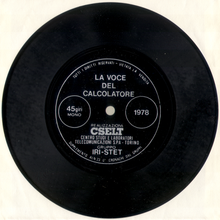
Multichannel Speaking Automaton (MUSA) was an early prototype of Speech Synthesis machine started in 1975.
Description
It consisted of a stand-alone computer hardware and a specialized software that implemented a diphone-synthesis technology. It was one of the first real-time TTS systems. It was able to read Italian in intellegibile robotic voice and also to sing managing up to 8 synthesis channels in parallel thanks to Linear predictive coding technology. In 1978 it was released, after the building of a working prototype, a 45" rpm audio disk containing some trial content of such synthesis, including the song "Fra Martino Campanaro" in "a cappella" (multiple voices) style, attached to some commercial reviews. The experiment was conducted by CSELT, Turin, Italy and was led by Giulio Modena.
See also
Notes
- Nebbia, Luciano; Lucchini, Paolo (April 1979). "Eight-channel digital speech synthesizer based on LPC techniques". ICASSP '79. IEEE International Conference on Acoustics, Speech, and Signal Processing. Vol. 4. pp. 884–886. doi:10.1109/ICASSP.1979.1170598.
- Billi, Roberto; Canavesio, Franco; Ciaramella, Alberto; Nebbia, Luciano (1 November 1995). "Interactive voice technology at work: The CSELT experience". Speech Communication. 17 (3): 263–271. doi:10.1016/0167-6393(95)00030-R.
- Cantoni, Virginio; Falciasecca, Gabriele; Pelosi, Giuseppe, eds. (2011). Storia delle telecomunicazioni (in Italian). Vol. 1. Firenze: Firenze University Press. ISBN 9788864532431.
- Umberto Oddone (5 December 1978). "Ho sentito il calcolatore elettronico che sa cantare "Fra Martino campanaro"". La Stampa (in Italian). p. 15.
References
- Pieraccini, Roberto (2012). The voice in the machine : building computers that understand speech. Cambridge, Mass.: MIT Press. ISBN 978-0262533294.
External links
- "MUSA" (in Italian). Archivio Storico Telecom Italia. Archived from the original on 2018-01-02.
- Baggia, Paolo (2006). "W3C: Speech Technologies and Standards - DIT Seminars, Povo, Trento" (PDF). W3C (in Italian). Retrieved June 22, 2022.